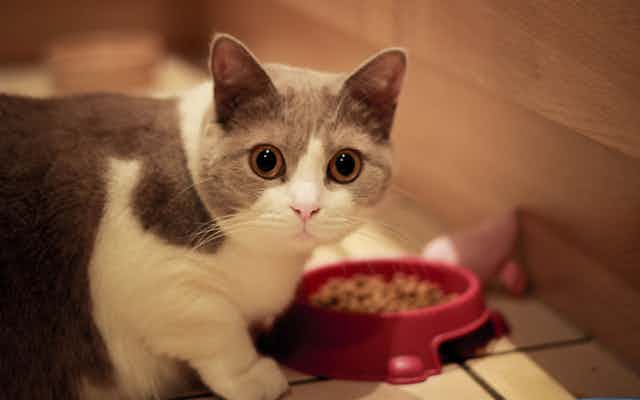Pet food is an industry worth nearly US$25 billion in the United States. Owners make decisions about what to feed their pets based on marketing, personal beliefs and pet preference. And as with human nutrition, it can be hard to sort out truth from fads and marketing from science.
Current pet food trends encourage owners to feed their pets much the same foods that humans eat: high-quality “human grade” meat and organic produce, maybe even some “superfoods.” While this approach is emotionally appealing, it is not necessary for pets’ health, nor is it environmentally sustainable.
Pets can have a large ecological footprint, and their food is a big contributing factor. Sustainable living experts Robert and Brenda Vale suggest in their book “Time to Eat the Dog? The Real Guide to Sustainable Living” that a medium-size dog could have a similar footprint to a large SUV. Other experts have come to similar conclusions about the sustainability of feeding pets.
Our Clinical Nutrition Team at Cummings School of Veterinary Medicine at Tufts University recently published a Pet Food IQ quiz written by three board-certified veterinary nutritionists. As the quiz demonstrates, there are many myths about feeding pets, and cats’ and dogs’ nutritional needs are different from human needs in some important ways. By understanding these differences, owners can keep their pets healthy while minimizing impacts on the environment.
- It’s all about the meat. Making pet food takes a lot of animal protein, and the current trend is to feed our pets high-meat diets. Typical dog foods contain 20 to 40 percent protein, while cat foods range from 30 to 60 percent, much of it from animal sources. Meat-based diets for humans and animals alike have much larger ecological footprints than plant-based diets, because it takes lots of land, water and food to feed pigs, cows, sheep, poultry and farmed fish.

By-products are sustainable and healthy for animals to consume. The best way to feed our pets meat-based diets with minimal footprints is to use every part of the animals we slaughter for human food, including organs. These ingredients (which do not include hair, horns, teeth or intestinal contents), often collectively termed “by-products,” can be very good-quality sources of nutrients that pets enjoy. While the pet food industry is well aware of this issue, many companies persist in telling pet owners that by-products should be avoided to make their own diets more appealing.
What’s good for humans isn’t always ideal or necessary for pets. Some manufacturers use the term “human-grade” to describe pet food or ingredients, but the phrase has no legal meaning and does not necessarily connote anything about quality or nutritional value. To be sold as food for humans, a product must never leave the human food production chain. While this requirement sounds good, it adds unnecessary cost and may eliminate the use of many high-quality, sustainable ingredients that people normally don’t eat. Pets need good-quality food, but they don’t have to compete for the same steak their owner is buying when they will happily and healthily eat organ meats or less-pretty trimmings.

Cats and dogs can eat diets containing properly cooked grain and other plant ingredients. Contrary to many reports, there are no documented health benefits to feeding pets a grain-free diet or one that avoids other plant ingredients. According to a recent study, one of the main genetic differences between dogs and wolves is that dogs have an increased ability to obtain nutrients from grains and other plants. Current grain-free diet trends are about selling pet food, not about pet health, and can lead to less sustainable diets.
But vegetarian and vegan diets aren’t always the best choices, either. Although some human vegetarians and vegans choose their diets based on sustainability concerns as well as animal welfare, dogs and especially cats generally do best with at least some animal products in their diets. While eggs and dairy can be good options, strict vegan diets may cause health problems for pets. Dogs are omnivores and more flexible, but cats are true carnivores and have special nutrient needs that are hard to meet with plants alone. Thus, cats should be fed diets that contain animal protein and other animal-sourced nutrients.
One easy way to reduce the environmental impact of pet food is to use less of it. Obesity is a major problem for pets as well as for humans in the United States, and the root cause of most weight gain is eating more calories than needed.
The bottom line is that choices about your pet’s diet can have implications for its health, your wallet and the planet. You can have both a healthy and more sustainable approach by feeding your dog or cat diets that contain moderate amounts of meat and use animal by-products, and feeding your pet only the amount of food it needs to maintain a healthy lean body weight.

